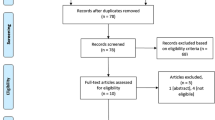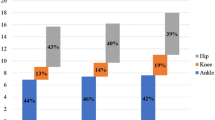Abstract
Purpose
Gait analysis is a valuable instrument for measuring function objectively after unicompartmental knee arthroplasty (UKA). However, most gait analysis studies have reported conflicting results for functional assessment after UKA. This meta-analysis compared the gait patterns of UKA patients and healthy controls during level walking.
Methods
Studies were included in the meta-analysis if they recorded vertical ground reaction force (GRF), flexion at initial contact, flexion at loading response, extension at mid-stance, flexion at swing, walking speed, cadence, and stride length in UKA patients or healthy controls.
Results
Seven studies met the criteria for inclusion in the meta-analysis. The UKA patients and healthy controls were similar in terms of vertical GRF (95% CI − 0.54 to 0.23; ns), flexion at initial contact (95% CI − 0.47 to 4.96; ns), flexion at loading response (95% CI − 1.29 to 3.69; ns), and flexion at swing (95% CI − 8.85 to 0.40; ns). In contrast, extension at mid-stance (95% CI 0.53 to 4.88; P = 0.01), walking speed (95% CI − 2.13 to − 0.15; P = 0.02), cadence (95% CI − 1.02 to − 0.25; P = 0.001), and stride length (95% CI − 2.02 to − 0.22; P = 0.01) differed significantly between groups. Subgroup analyses revealed that the pooled data were similar between groups: 1st maximum (heel strike), − 0.43 BW (ns); 1st minimum (mid-stance), 0.61 BW (ns); and 2nd maximum (toe off), − 0.46 BW (ns).
Conclusions
There were no significant differences in vertical GRF or overall kinematics in the sagittal plane between UKA patients and healthy controls during level walking. However, the UKA group had a significantly slower walking speed and cadence and a shorter stride length than healthy controls. The current findings suggest that, clinically, UKA fails to completely restore normal gait patterns.
Level of evidence
Level II, therapeutic study.




Similar content being viewed by others
References
Andriacchi T, Ogle J, Galante J (1977) Walking speed as a basis for normal and abnormal gait measurements. J Biomech 10(4):261–268
Andriacchi TP, Galante JO, Fermier RW (1982) The influence of total knee-replacement design on walking and stair-climbing. J Bone Joint Surg Am 64(9):1328–1335
Argenson JN, Komistek RD, Aubaniac JM et al (2002) In vivo determination of knee kinematics for subjects implanted with a unicompartmental arthroplasty. J Arthroplast 17(8):1049–1054
Bade MJ, Kohrt WM, Stevens-Lapsley JE (2010) Outcomes before and after total knee arthroplasty compared to healthy adults. J Orthop Sports Phys Ther 40(9):559–567
Catani F, Benedetti MG, Bianchi L, Marchionni V, Giannini S, Leardini A (2012) Muscle activity around the knee and gait performance in unicompartmental knee arthroplasty patients: a comparative study on fixed- and mobile-bearing designs. Knee Surg Sports Traumatol Arthrosc 20(6):1042–1048
Chassin EP, Mikosz RP, Andriacchi TP, Rosenberg AG (1996) Functional analysis of cemented medial unicompartmental knee arthroplasty. J Arthroplasty 11(5):553–559
Choy WS, Kim HY, Kim KJ, Kam BS (2007) A comparison of gait analysis after total knee arthroplasty and unicompartmental knee arthroplasty in the same patient. J Korean Orthop Assoc 42(4):505–514
Fuchs S, Tibesku CO, Frisse D, Laass H, Rosenbaum D (2003) Quality of life and gait after unicondylar knee prosthesis are inferior to age-matched control subjects. Am J Phys Med Rehabil 82(6):441–446
Geller JA, Yoon RS, Macaulay W (2008) Unicompartmental knee arthroplasty: a controversial history and a rationale for contemporary resurgence. J Knee Surg 21(1):7–14
Greene KA, Schurman JR, 2nd (2008) Quadriceps muscle function in primary total knee arthroplasty. J Arthroplasty 23(7 Suppl):15–19
Heiden TL, Lloyd DG, Ackland TR (2009) Knee joint kinematics, kinetics and muscle co-contraction in knee osteoarthritis patient gait. Clin Biomech (Bristol Avon) 24(10):833–841
Jones GG, Kotti M, Wiik AV et al. (2016) Gait comparison of unicompartmental and total knee arthroplasties with healthy controls. Bone Joint J 98-B(10 Supple B):16–21
Kim KT, Lee S, Lee JI (2016) Analysis and treatment of complications after unicompartmental knee arthroplasty. Knee Surg Relat Res 28(1):46–54
Kim YJ, Kim BH, Yoo SH (2017) Mid-term results of Oxford medial unicompartmental knee arthroplasty in young asian patients less than 60 years of age: a minimum 5-year follow-up. Knee Surg Relat Res 29(2):122–128
Ko YB, Gujarathi MR, Oh KJ (2015) Outcome of unicompartmental knee arthroplasty: a systematic review of comparative studies between fixed and mobile bearings focusing on complications. Knee Surg Relat Res 27(3):141–148
Mattsson E, Olsson E, Broström L-Å (1990) Assessment of walking before and after unicompartmental knee arthroplasty. A comparison of different methods. Scand J Rehab Med 22(1):45–50
Metcalfe A, Stewart C, Postans N et al (2013) Abnormal loading of the major joints in knee osteoarthritis and the response to knee replacement. Gait Posture 37(1):32–36
Mundermann A, Dyrby CO, Hurwitz DE, Sharma L, Andriacchi TP (2004) Potential strategies to reduce medial compartment loading in patients with knee osteoarthritis of varying severity: reduced walking speed. Arthritis Rheum 50(4):1172–1178
Saari T, Tranberg R, Zugner R, Uvehammer J, Karrholm J (2005) Changed gait pattern in patients with total knee arthroplasty but minimal influence of tibial insert design: gait analysis during level walking in 39 TKR patients and 18 healthy controls. Acta Orthop 76(2):253–260
Saccomanni B (2010) Unicompartmental knee arthroplasty: a review of literature. Clin Rheumatol 29(4):339–346
Smith AJ, Lloyd DG, Wood DJ (2004) Pre-surgery knee joint loading patterns during walking predict the presence and severity of anterior knee pain after total knee arthroplasty. J Orthop Res 22(2):260–266
Stacoff A, Kramers-de Quervain IA, Luder G, List R, Stussi E (2007) Ground reaction forces on stairs. Part II: knee implant patients versus normals. Gait Posture 26(1):48–58
Studenski S, Perera S, Patel K et al (2011) Gait speed and survival in older adults. JAMA 305(1):50–58
Van Kan GA, Rolland Y, Andrieu S et al (2009) Gait speed at usual pace as a predictor of adverse outcomes in community-dwelling older people an International Academy on Nutrition and Aging (IANA) Task Force. J Nutr Health Aging 13(10):881–889
Webster KE, Wittwer JE, Feller JA (2003) Quantitative gait analysis after medial unicompartmental knee arthroplasty for osteoarthritis. J Arthroplast 18(6):751–759
Wiik AV, Manning V, Strachan RK, Amis AA, Cobb JP (2013) Unicompartmental knee arthroplasty enables near normal gait at higher speeds, unlike total knee arthroplasty. J Arthroplast 28(9):176–178
Willis-Owen CA, Brust K, Alsop H, Miraldo M, Cobb JP (2009) Unicondylar knee arthroplasty in the UK National Health Service: an analysis of candidacy, outcome and cost efficacy. Knee 16(6):473–478
Zambianchi F, Digennaro V, Giorgini A et al (2015) Surgeon’s experience influences UKA survivorship: a comparative study between all-poly and metal back designs. Knee Surg Sports Traumatol Arthrosc 23(7):2074–2080
Acknowledgements
This work was supported by Inha University Hospital Research Grant. The authors would like to thank Ms. Jae-Ok Park for her help in preparing the manuscript.
Funding
No funding.
Author information
Authors and Affiliations
Corresponding author
Ethics declarations
Conflict of interest
The authors declare that they have no conflict of interest.
Ethical approval
For this retrospective study, ethical approval is not required.
Informed consent
For this type of study, formal consent is not required.
Rights and permissions
About this article
Cite this article
Kim, MK., Yoon, JR., Yang, SH. et al. Unicompartmental knee arthroplasty fails to completely restore normal gait patterns during level walking. Knee Surg Sports Traumatol Arthrosc 26, 3280–3289 (2018). https://doi.org/10.1007/s00167-018-4863-0
Received:
Accepted:
Published:
Issue Date:
DOI: https://doi.org/10.1007/s00167-018-4863-0




